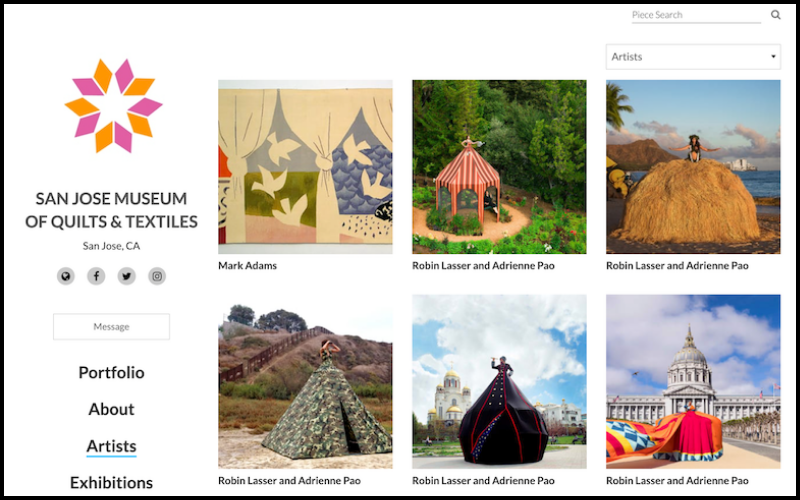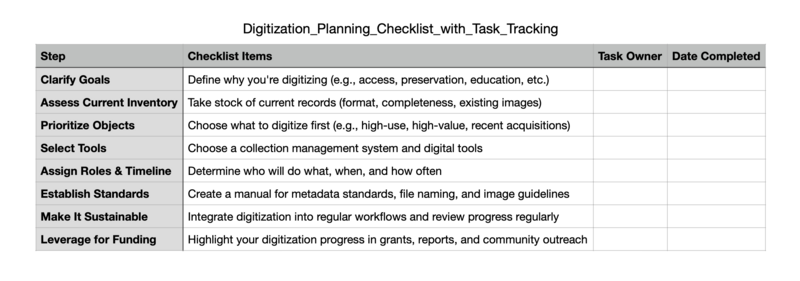 San Jose Museum of Quilts & Textiles brings their permanent collection, artists and exhibitions online with Artwork Archive's Public Profile–connected to their backend database.
San Jose Museum of Quilts & Textiles brings their permanent collection, artists and exhibitions online with Artwork Archive's Public Profile–connected to their backend database.
Turn limited resources into lasting impact with a practical and sustainable approach to digital collection care.
If you're working at a museum or another arts nonprofit, you've likely heard this advice: you should digitize your collection.
And it's true. Digitization opens the door to better preservation, broader access, and stronger engagement with your audiences. But it’s also true that getting started can feel overwhelming–especially with limited time, staff and resources.
This guide is here to help. We’ve outlined a realistic, step-by-step approach to help your arts nonprofit build a digitization plan that works for your team—and your mission.
Step 1: Define why you're digitizing
Before you scan a single object, ask: What are we trying to achieve?
Some common goals include:
-
Increasing public access to your collection
-
Improving inventory control and location tracking
-
Supporting educational programming or online exhibitions
-
Preparing for emergency response or disaster recovery
-
Enhancing donor or grant reporting
Tip: Clarify your goals upfront. It will help you prioritize what to digitize and how to structure your process. And, it will help secure buy-in from your team members and board members.
Step 2: Take inventory of what you have
Start by assessing your current collection records:
-
What formats are your records in? (paper, Excel, outdated database?)
-
How complete are they? It's common to find incomplete records or even records with conflicting data.
-
Do you have images, and if so, where are they stored?
Then, estimate:
-
Total number of objects
-
Object types (e.g., works on paper, textiles, sculptures)
-
Existing documentation gaps (e.g., missing dimensions, poor-quality photos)
Tip: Don’t try to digitize everything at once. Focus on what’s already partially documented or what aligns with your goals. Then you can tackle the conundrums in your collection when you have capacity.
Step 3: Prioritize what to digitize first
When resources are tight, prioritization is everything. Consider starting with:
-
High-value or high-risk items (e.g., fragile, rare, or frequently requested)
-
Objects that are frequently used for exhibitions or loans
-
Collections relevant to upcoming projects, anniversaries, or exhibitions
-
Recent acquisitions that already have digital documentation
Tip: Create a shortlist of 50–100 objects to start. Build momentum with small, achievable wins.
Step 4: Choose the right tools
You’ll need tools for:
-
Cataloging and collection management
-
Look for databases that support tags, acquisition details, provenance tracking, locations, loans, and contact management.
-
-
Image and document storage
-
Look for a database that not only will store your documents and photography (without additional charge) but will also easily allow you to share out the files.
-
-
Sharing your collection online
-
Look for a database that can be synced to your website so that you don't have to double enter data.
-
With platforms like Artwork Archive you'll have access to all of those tools in one, centralized, affordable, cloud-based, database that is intuitive for small teams.
Tip: Avoid reinventing the wheel. Use metadata standards (like Dublin Core or VRA Core) and built-in tools from platforms that specialize in collections. Avoid complicating your digital presence by utilizing Artwork Archive's website embed that is only one-line of code that can easily be added to your website.
Step 5: Set roles, responsibilities & realistic timelines
If your team is small (or it’s just you!), you’ll need to be strategic about distributing the work:
-
Can volunteers, interns, or board members help with data entry or photography?
-
Can you digitize in batches tied to exhibit rotations or seasonal availability?
-
Can you carve out 2–4 hours per week as dedicated “digitization time”?
Tip: Make it a recurring task, not a one-time project. Think of digitization as ongoing collections care. This is especially true if you're coordinating loans, donations or acquisitions–your collection will continue to evolve and need continued digitization support.
 Step 6: Build in standards from the start
Step 6: Build in standards from the start
Create a simple digitization manual for your team that includes:
-
Object naming conventions
-
Required fields (e.g., title, artist, date, medium, accession number)
-
Image specs (e.g., resolution, file types, naming format)
-
Guidelines for photography (lighting, angles, background)
Tip: A little consistency goes a long way. It will save you time and make your collection more usable.
Step 7: Make your process sustainable
Digitization doesn’t end once the objects are online. Consider:
-
Creating a checklist for digitizing new acquisitions
-
Scheduling quarterly “metadata review” days
-
Using your platform’s reporting tools to track progress and gaps
-
Sharing digitized content via exhibitions, social media, or donor reports
Tip: Sustainability = workflow + visibility. If your digitized assets get used, your team will stay motivated to keep the work going. For instance, more visits to your collection on your website an lead to more scholarly inquiries or more foot traffic.
Did you know that you can use your digitization efforts to attract funding?
Many museum professionals are surprised to learn that a commitment to digitization can pay off with granters or donors. Funders love seeing good stewardship in action. Your digitization plan can support:
-
Grant applications (especially for access, conservation, or outreach)
-
Donor cultivation (showcasing progress or wishlists)
-
Community partnerships (e.g., with local schools or researchers)
This practical guide will help you create a digital roadmap for your museum that’s achievable, strategic, and built to last.
Digitization is an investment—but it doesn’t have to be overwhelming. With a clear plan, the right tools, and a manageable pace, even the smallest museums can make meaningful progress.
Start small. Be consistent. And know that every object you digitize makes your collection more accessible, discoverable, and impactful.
With the right tools, your small museum can make big strides toward access, preservation, and engagement.




